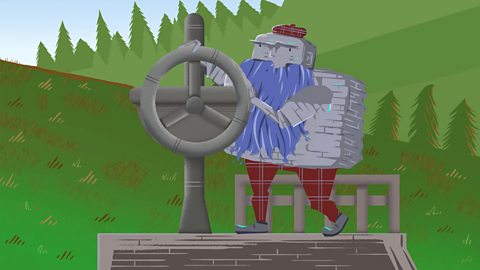What are batteries?
Batteries are stores of chemical energy that can be converted to electrical energy and used as a power source.
In this article you can learn about:
- What batteries are
- Different types of battery
- New ideas about storing energy
- What the advantage and disadvantages of batteries are
This resource is suitable for energy and sustainability topics for primary school learners.
Video - Batteries and energy stores
In this video, learn about different types of batteries and how they work.
Watch this short video to find out about different types of batteries and energy stores.
Meet the Batt-men! They're… well they're batteries.
But, unlike that Bat-man they might be able to save the world in real life (plus they have a lot more outfits)
First off there's alkaline Batt-man. He comes in little cylinders and powers our torches and, yes, our TV remotes. He's really handy if you need a wee bit of power in a portable package. But he’s not very… energetic.
Unlike gadget-carrying Lithium-ion Batt-man, who powers computers, mobile phones and even electric cars. He can be recharged and he packs a real punch.
Big lithium-ion batteries are used in places like solar farms to store extra electricity, which can then be used to power our homes when the sun goes down.
But lithium-ion batteries are expensive, there isn’t much lithium about and mining it causes pollution, and he can get hot which wastes energy.
But there may be more heroes to the rescue.
Like Hydrogen Batt-man. He isn't even really a battery – he's an engine. When we combine hydrogen with oxygen in a fuel cell, it generates electricity. And unlike smelly petrol engines, its only output is H20 - water!
Hydrogen fuel cells already power lots of our vehicles, like forklift trucks and buses. But hydrogen batt-man has a bit of a pollution problem. At the moment his hydrogen mainly comes from the burning of fossil fuels, which pollute our atmosphere.
And finally, coming soon, Gravity-storage Batt-man.At his simplest, he is a big block of concrete. When extra power is being generated by wind or solar the concrete is raised up. And then, when they aren't working so well, the concrete is dropped. This kinetic energy turns turbines and a generator - and produces electricity for our homes.
If we can develop enough different types of batteries, then we can store more electricity from renewable energies …which helps us to fight climate change. So, the Batt-men really are superheroes!
Why are batteries useful?
Batteries can be used to power portable devices. They let devices use electricity without the need to be plugged into main electricity sources, such as wall sockets. Mobile phones, tablets, the TV remote and torches all use batteries.
Some batteries are rechargeable so they can be used again and again. Charging them with electricity from renewable sources can help us fight climate change by reducing our need to burn fossil fuels.
Types of batteries
What are alkaline batteries?
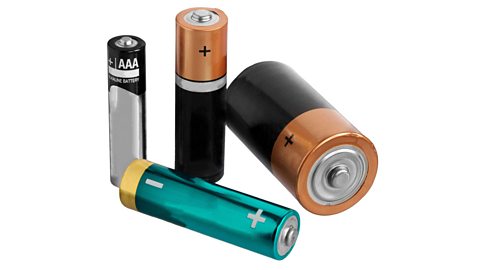
Alkaline batteries are the type of battery we use for things like TV remotes, games controllers and torches.
These batteries have a small amount of power and are easy to move around or remove. However, once their energy is used up, they need to be recycled.
Some types of alkaline batteries are rechargeable so they can be reused many times before they need to be recycled.

What are lithium-ion batteries?
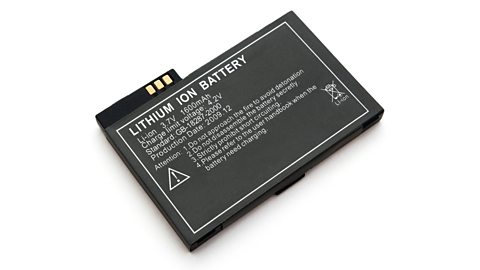
These power things that need more energy than an alkaline battery, such as computers, mobile phones and electric cars. Once their energy is used, they can simply be recharged.
Lithium batteries are expensive to make and mining the materials needed for them, such as cobalt, causes pollution. These materials are also often in parts of the world with poor worker’s rights and dangerous working conditions, such as the Democratic Republic of Congo.
Lithium-ion batteries can also waste a lot of heat energy when they get hot.
Did you know?
- When you recharge your phone you are recharging the phone’s lithium-ion battery.
- Some solar farms use huge lithium batteries to store the electricity captured by solar panels. The batteries can then supply this electricity to the National Grid at night or on cloudy days when the solar panels are not generating any electricity.

What are hydrogen batteries?
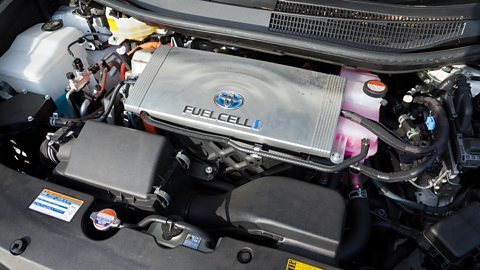
A hydrogen battery is like an engine. It stores hydrogenA very common gas. It has no smell, taste or colour. It is the most common chemical element in the universe. which can be combined with oxygen in a chemical reaction that releases energy. Apart from energy this reaction only produces water. There is no pollution and no carbon dioxide or other greenhouse gases are released.
However, lots of the hydrogen is produced by burning fossil fuels. Using hydrogen batteries might not harm the environment, but fueling them can be harmful.

What are gravity storage batteries?

Gravity storage is a new method of storing energy, so it works a bit like a battery.
A large block of concrete is placed on a system of pullies up a tower or in a deep hole, like a mine shaft. When more electricity is being generated than is being used, instead of this energy being wasting it can be used to power a winch that pulls the concrete block to the top of the hole.
When more electricity is needed, the concrete block is lowered. This movement turns a turbine which generates electricity.

Recycling batteries
Batteries contain harmful chemicals that can leak as the battery rots and cause damage to the environment. This makes it important to recycle batteries if we can.
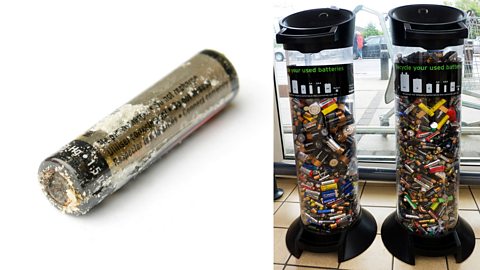
The advantages and disadvantages of batteries
Advantages
Batteries store energy which means we can reduce waste of energy. This can help us to reduce the amount of non-renewable energy we use and therefore helps the environment.
Many batteries are easy to remove and replace or recharge.
Many batteries are small and portable, so they can provide electricity for mobile devices and vehicles.
Disadvantages
Some batteries are expensive to make or cause pollution in the process of making them.
Some batteries such as lithium-ion batteries use materials which are mined in places where worker’s rights and children’s rights might have been abused.
Chemicals from old batteries can pollute the ground and water supplies, unless they are recycled.

Key words about batteries
Sorry, something went wrongCheck your connection, refresh the page and try again. - Batteries contain chemicals and chemical energy is the energy stored within these chemicals. Energy is released when there is a chemical reaction between these chemicals.
Sorry, something went wrongCheck your connection, refresh the page and try again. - This is when one or more substances react with each other creating a new substance. When you make a cake or bake bread, chemical reactions take place and a new substance is formed.
Sorry, something went wrongCheck your connection, refresh the page and try again. - Fossil fuels are fuels that come from the Earth. Fossil fuels are all old life forms that have decomposed and been compressed over a long period of time underground or under the sea. Coal, oil and gas are fossil fuels. Learn more here: What are fossil fuels?
Sorry, something went wrongCheck your connection, refresh the page and try again. - Hydrogen is a very common gas. It has no smell, taste or colour. It is the most common chemical element in the universe.
Test your knowledge
Quiz
Challenge
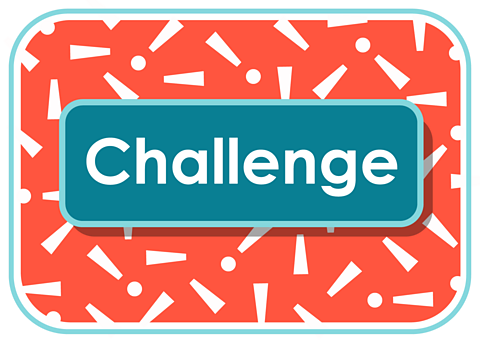
Find and make a list of all the battery-operated devices in your house
In the list note whether it has an alkaline battery (one that can be removed, replaced and recycled when its energy is used) or a lithium-ion battery (one that can be recharged).
Make a tally chart of how many there are of each battery type.
Learn more about making tally tables and other charts here: How do I record and display data?
Important! Ask an adult for help in doing this task as some battery-operated devices in your house might be unsafe to handle by yourself.
More on Sustainability
Find out more by working through a topic
- count16 of 28

- count17 of 28
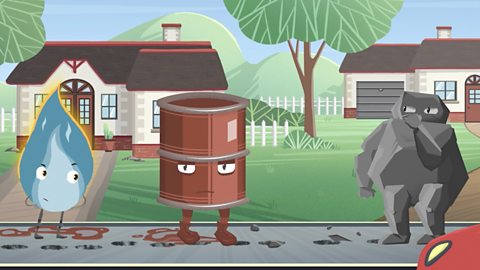
- count18 of 28
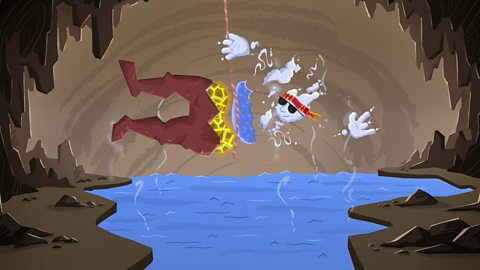
- count19 of 28
